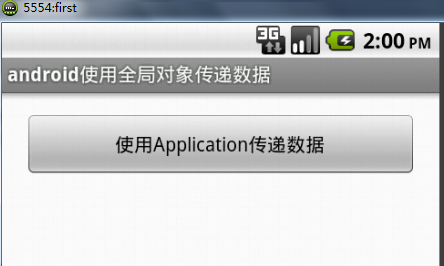1、全局对象是Activity之间传递数据的一种比较实用的方式,比如在JavaWeb中有四个作用域,这四个作用域从小到大分别是Page、Request、Session和Application,其中Application域在应用程序的任何地方都可以使用和访问,除非是Web服务器停止。Android中的全局对象非常类似于JavaWeb中的Application域,只要Android应用程序不清除内存,全局对象就可以一直访问~
2、新建一个Android项目:“android_app”,进入“main.xml”添加一个Button,代码如下:
<Button
android:id="@+id/button"
android:layout_width="fill_parent"
android:layout_height="wrap_content"
android:text="使用Application传递数据" />
3、在当前目录下创建一个“other.xml”,添加一个TextView,代码如下:
<TextText
android:id="@+id/msg"
android:layout_width="fill_parent"
android:layout_height="wrap_content" >
</TextText>
4、在当前包下新建一个类“OtherActivity”,并使其继承Activity;添加一个“onCreate”方法,代码如下:
package com.android.app;
import android.app.Activity;
import android.os.Bundle;
public class OtherActivity extends Activity {
@Override
protected void onCreate(Bundle savedInstanceState) {
// TODO Auto-generated method stub
super.onCreate(savedInstanceState);
setContentView(R.layout.other);
}
}
5、为了能在程序中使用全局变量,需要在当前包下新建一个普通类“MyApp”,使其继承“Application”,随后声明一个“name”成员并提供构造方法和添加“onCreate”代码如下:
package com.android.app;
import android.app.Application;
public class MyApp extends Application {
private String name;
public String getName() {
return name;
}
public void setName(String name) {
this.name = name;
}
@Override
public void onCreate() {
// TODO Auto-generated method stub
super.onCreate();
setName("张三");
}
}
6、进入“Main.java”,添加Button和MyApp成员,随后为Button设置一个点击的事件,代码如下:
package com.android.app;
import android.os.Bundle;
import android.app.Activity;
import android.content.Intent;
import android.view.Menu;
import android.view.View;
import android.widget.Button;
public class Main extends Activity {
private Button button;
private MyApp myApp;
@Override
protected void onCreate(Bundle savedInstanceState) {
super.onCreate(savedInstanceState);
setContentView(R.layout.activity_main);
button = (Button) this.findViewById(R.id.button);
// 为button注册一个点击事件
button.setOnClickListener(new View.OnClickListener() {
@Override
public void onClick(View v) {
// TODO Auto-generated method stub
myApp = (MyApp) getApplication();
myApp.setName("Jack");// 修改之后的名字
Intent intent = new Intent(Main.this, OtherActivity.class);
startActivity(intent);
}
});
}
@Override
public boolean onCreateOptionsMenu(Menu menu) {
// Inflate the menu; this adds items to the action bar if it is present.
getMenuInflater().inflate(R.menu.main, menu);
return true;
}
}
7、进入“OtherActivity.java”中,声明一个MyApp成员,并获取myApp,代码如下:
package com.android.app;
import android.app.Activity;
import android.os.Bundle;
import android.widget.TextView;
public class OtherActivity extends Activity {
private MyApp myApp;
private TextView textView;
@Override
protected void onCreate(Bundle savedInstanceState) {
// TODO Auto-generated method stub
super.onCreate(savedInstanceState);
setContentView(R.layout.other);
textView = (TextView) this.findViewById(R.id.msg);
myApp = (MyApp) getApplication();
textView.setText("-appname-->>" + myApp.getName());
}
}
8、修改清单文件“AndroidManifest.xml”,在“Application”标签中新加入一个属性“name”,再加入一个“Activity”,代码如下:
<application
android:name=".MyApp"//后添加的属性
android:allowBackup="true"
android:icon="@drawable/ic_launcher"
android:label="@string/app_name"
android:theme="@style/AppTheme" >
<activity
android:name="com.android.app.Main"
android:label="@string/app_name" >
<intent-filter>
<action android:name="android.intent.action.MAIN" />
<category android:name="android.intent.category.LAUNCHER" />
</intent-filter>
</activity>
<activity android:name=".OtherActivity" >//后添加的标签
</activity>
</application>
9、运行一下,得到结果:
